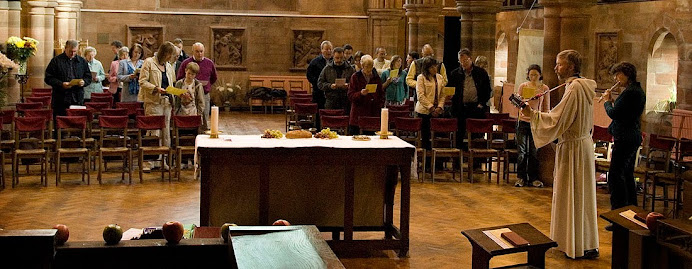Jeremiah 51, Psalm 51, Hebrews 5, John 12
Some Greeks had come to worship in Jerusalem at Passover. They asked
Philip if they could see Jesus, Philip asked Andrew, and then they went.
There seems to have been an air of exclusivity around Jewish holy men,
at least in the minds of some people.
Passover is not the
most important Jewish festival. It doesn't define or renew the
covenant, but it does celebrate the freedom of God's chosen people and
their foundation as a nation. Some Greeks wanted to be part of that.
Perhaps that's why Jesus identified the moment as the beginning of his
'hour of glory'.
But why did some Greeks want to identify
with a people whose origin lay in an escape from slavery? Did they feel
that they, too, were longing for a freedom that seemed slightly beyond
reach? Traditionally, Greeks seek wisdom while Jews seek a sign. Did
these Greeks recognise in Jesus not only a sign of liberation, but the
wisdom that might lead to it? We can't know what was in their minds, but
we can work on tho twin ideas of sign and wisdom.
Jesus
was, to his followers, a sign that God is active in the world:
recognisable as God in action, but not limited to what people already
thought they knew about God. Jesus was also a source of wisdom:
demonstrating a deep understanding of human life and human nature, and
leading people to a new understanding of their own lives.
Create in us a clean heart O God:
And renew a right spirit within us.
Sunday 22 March 2015
Art and Artists
Numbers 21, Ephesians 2, John 3
One of the three themes running through today's readings is art. The bronze serpent (Numbers 21) was not commissioned as a work of art - more a sacred talisman - but it would undoubtedly be seen as a work of art if, nearly 3,000 years later, we still had it. Unfortunately, it was destroyed during the Reformation on the orders of the King (Hezekiah, 2 Kings 18).
The image of the serpent crops up in Jesus' late night conversation with Nicodemus. The original artefact saved lives. Jesus, similarly lifted up for all to see, would also save lives, but with a difference: we're not getting bitten by snakes. What are we getting bitten by? Is this the moment to explore the symbolic association of the serpent with sin? Or with wisdom? Or is it just the moment to reflect on the fact that being bitten, one way or another, is a more or less common experience?
Like the bronze serpent, a crucifix or a cross can be treated as a work of art. Also like the serpent, the image of suffering can function as a symbol of healing, and carries the risk of becoming an object of devotion in its own right.
Finally, I want to turn from the art treasures of human history to God's work of art: us. We're a work in progress. How do we imagine God working? Chisel? Brushes? A composer's pencil or a conductor's baton? Human beings can be amazing, and there is an occasional risk of treating them as objects of worship. Then, in our occasional reformations, we destroy them. History tells many a fascinating and tragic tale. The unfortunate fact of the matter is that what we get bitten by is usually human beings. The saving grace that we celebrate, however, enables human beings to be a source of healing.
One of the three themes running through today's readings is art. The bronze serpent (Numbers 21) was not commissioned as a work of art - more a sacred talisman - but it would undoubtedly be seen as a work of art if, nearly 3,000 years later, we still had it. Unfortunately, it was destroyed during the Reformation on the orders of the King (Hezekiah, 2 Kings 18).
The image of the serpent crops up in Jesus' late night conversation with Nicodemus. The original artefact saved lives. Jesus, similarly lifted up for all to see, would also save lives, but with a difference: we're not getting bitten by snakes. What are we getting bitten by? Is this the moment to explore the symbolic association of the serpent with sin? Or with wisdom? Or is it just the moment to reflect on the fact that being bitten, one way or another, is a more or less common experience?
Like the bronze serpent, a crucifix or a cross can be treated as a work of art. Also like the serpent, the image of suffering can function as a symbol of healing, and carries the risk of becoming an object of devotion in its own right.
Finally, I want to turn from the art treasures of human history to God's work of art: us. We're a work in progress. How do we imagine God working? Chisel? Brushes? A composer's pencil or a conductor's baton? Human beings can be amazing, and there is an occasional risk of treating them as objects of worship. Then, in our occasional reformations, we destroy them. History tells many a fascinating and tragic tale. The unfortunate fact of the matter is that what we get bitten by is usually human beings. The saving grace that we celebrate, however, enables human beings to be a source of healing.
Subscribe to:
Posts (Atom)
